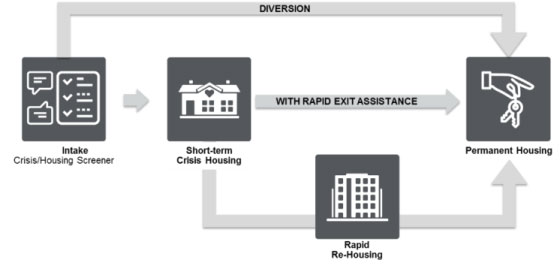Upcoming changes to the way in which Continuums of Care (CoCs) report HMIS data to HUD each year will provide communities with new analysis tools. These tools will allow CoCs to develop a much more granular understanding of how homelessness is experienced in their jurisdiction and how their homeless systems operate, in addition to providing information for HUD’s Annual Homeless Assessment Report to Congress (AHAR). To reflect this broader purpose, AHAR reporting will be renamed Longitudinal Systems Analysis (LSA).
This blog is the first in a series on how communities have used HMIS data to support community planning to improve responses to homelessness. In this post, we introduce system modeling, an exercise that enables communities to think through how individuals and families move through their homeless services system and use that information to develop a model to understand the relative type and amount of each project type needed to address homelessness, and changes needed to adjust the homeless system response to better end homelessness. Subsequent posts will describe how one community used system modeling to design a more effective response to youth homelessness and provide more detail on the upcoming transition from AHAR to LSA.
Local homeless services systems comprise a series of interconnected interventions. The programs that people access, the way they move between programs, and the length of time they stay in each program, all have repercussions for other parts of the system. When the relationships between these interventions are well understood, a community can “right-size” each component to address peoples’ actual needs and preferences and achieve an efficient and effective allocation of resources.
System modeling makes this type of analysis possible. Through this approach, CoCs determine the amount of each intervention to provide, based on assumptions about the annual inflow of people seeking assistance (overall and for priority populations), the share of those people that will need different types of interventions, and the time spent in each intervention. CoCs will be able to use LSA data to support a more data-driven system modeling process.
System modeling generally involves the following steps:
1. Map out the components of their desired homeless services system (e.g., short-term crisis housing beds, rapid re-housing, permanent supportive housing).
2. Estimate the annual number of people served, including any populations that have been prioritized for assistance (e.g., youth or people with chronic patterns of homelessness).
3. Review actual system utilization data to determine the types of programs people access, how long they stay, and whether they exit to permanent housing, another program, or elsewhere.
4. Identify “ideal” pathways, meaning combinations of interventions that would improve housing outcomes for people experiencing homelessness.
5. Develop assumptions about the percentage of people that would need each pathway to exit to permanent housing and the average length of assistance expected to be needed from each system component.
6. Use these assumptions to develop a model for an ideal homeless services system that efficiently and effectively allocates resources to serve those who need minimal intervention to be successfully placed in permanent housing and those who need more intensive interventions. System models can be designed to generate inventory targets for each system component and estimates of the cost to meet these targets. Or given inventory projections, models can help CoCs assess the extent to which they can meet need with projected system resources.
7. Adjust the allocation of resources within the system as needed and on an ongoing basis to maximize efficiency and effectiveness.
In an upcoming blog, we will look at how one community used system modeling to design and scale its response to youth homelessness.
 Brooke Spellman is a national leader in conducting research and developing strategies to improve policy and programmatic responses to homelessness and poverty. A principal associate in the Social & Economic Policy Division of Abt Associates, she has expertise in using Homeless Management Information System (HMIS) and mainstream system administrative data to understand homelessness, patterns of homeless service utilization, client outcomes, and homeless and mainstream system costs. Learn more
Brooke Spellman is a national leader in conducting research and developing strategies to improve policy and programmatic responses to homelessness and poverty. A principal associate in the Social & Economic Policy Division of Abt Associates, she has expertise in using Homeless Management Information System (HMIS) and mainstream system administrative data to understand homelessness, patterns of homeless service utilization, client outcomes, and homeless and mainstream system costs. Learn more
March 2018
